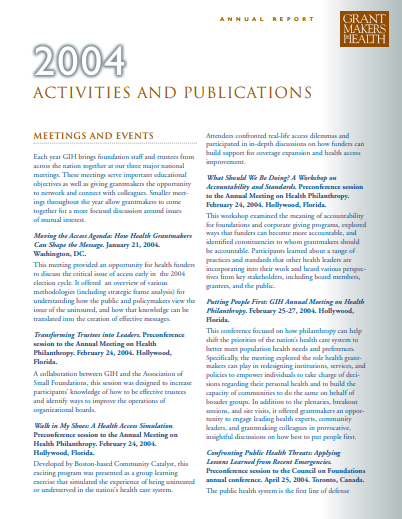In Harm’s Way: Aiding Children Exposed to Trauma
Every year, thousands of children nationwide experience trauma as a result of exposure to violence, abuse, or disasters. These traumatic events create intense stress that threatens children’s mental health and well-being. Fortunately, early intervention and access to appropriate treatment services can ameliorate the immediate and long-term effects of exposure to trauma.
For the Benefit of All: Ensuring Immigrant Health and Well-Being
Immigrants and their families contribute to the diversity and economy of the nation, contributing to vibrant, productive, and healthy communities. Yet, immigrants face several barriers to health and well-being. Some result from being disproportionately low income and uninsured; others are unique, such as cultural and linguistic barriers; limited eligibility for public benefits; and bearing the brunt of unwelcoming public views, attitudes, and policies.
Agents of Change
This resource portfolio is from GIH’s 2005 annual meeting, Agents of Change: Health Philanthropy’s Role in Transforming Systems.
Annual Report 2004
GIH’s 2004 Annual Report document’s the organization’s programmatic and financial activities.
Medicaid: Vital to Women’s Health
Although Medicaid is not usually perceived as a women’s health program, it covers critically important medical care for 12 million American women. Grantmakers with a focus on women’s health are paying close attention to proposals to restructure the Medicaid program, which could have major implications for low-income women’s access to health care services.
Improving the Health and Well-being of Children in Foster Care
As a group, children in foster care may be the unhealthiest children in America. They are substantially more likely to have health problems than children in other groups at risk for poor health status, including children in low-income families, homeless children, and children in families receiving public assistance.
Improving Health Access in Communities: Lessons for Effective Grantmaking
Improving Health Access in Communities: Lessons for Effective Grantmaking highlights grantmaking lessons from two initiatives designed to help alleviate the burden of high uninsurance rates at the local level: Communities in Charge program, funded by The Robert Wood Johnson Foundation (RWJF), and Community Voices, funded by the W.K. Kellogg Foundation. This report details the valuable strategic lessons learned from these initiatives. Lessons related to developing community coalitions, creating successful grantor-grantee relationships, and understanding the comparative advantages of national and local funders are relevant to grantmakers funding or planning to fund in this and other health issues.
Funding Health Advocacy
Funding Health Advocacy incorporates the essence and richness of the discussion at GIH’s November 2004 Issue Dialogue on health advocacy with a background paper previously prepared for the meeting. It focuses on the challenges and opportunities involved with funding advocacy and engaging in public policy work. This Issue Brief complements GIH’s ongoing work to support grantmakers in their efforts to fund policy-relevant projects and builds upon GIH’s track record of work on grantmakers’ strategies for shaping public policy.
The Business of Giving: Governance and Asset Management in Foundations Formed From Health Care Conversion
This report looks at the composition and function of boards of directors in foundations formed from health care conversions, as well as how the foundations manage the investment of their assets. This report is the latest in GIH’s series of reports on these foundations.
Getting Prescription Drugs to Those Who Need Them Most
There are major changes taking place in the way elderly and disabled people pay for prescription drugs. These changes are being ushered in by the new Medicare law, which, if it lives up to its promise, will be incredibly helpful to some of the most vulnerable members of our society. What are the details of the new law? How many people will it affect? How will low-income people be assisted? What are the implementation challenges? How are they being addressed by the federal government? What can grantmakers do to help?

